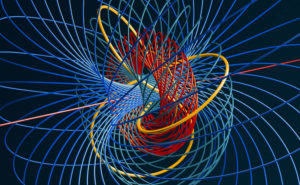This post is the third of a series on connections on foliated manifolds.
- The Bott connection on foliated manifolds,
- Tanno’s connection on contact manifolds,
- The equivalence of Bott and Tanno’s connections on \(K\)-contact manifolds with the Reeb foliation,
- Connections on codimension 3 sub-Riemannian manifolds.
In the last two posts, we have discussed basic properties of the Bott connection on general foliated manifolds and Tanno’s connection on contact manifolds. Here we will show that the two notions are equivalent under a certain condition on the contact structure.
Throughout this post, all manifolds will be smooth.
3. Bott and Tanno’s connections on \(K\)-contact manifolds
The key property we want on a contact manifold is the following:
Definition 3.1
Let \((\mathbb{M},\theta,g)\) be a contact manifold with compatible metric \(g\). We call \(\mathbb{M}\) a \(K\)-contact manifold if the associated Reeb field \(\xi\) is a Killing field, that is if
\[\mathcal{L}_\xi g = 0\]
We are interested in \(K\)-contact manifolds because of the following
Proposition 3.2
Let \((\mathbb{M},\theta,g,\mathcal{F}_\xi)\) be a contact manifold equipped with Reeb foliation \(\mathcal{F}_\xi\). Then the following are equivalent:
- \((\mathbb{M},\theta,g)\) is a \(K\)-contact manifold,
- \((\mathbb{M},g,\mathcal{F}_\xi)\) is a totally-geodesic foliation with bundle-like metric \(g\).
Remark: Boyer and Galicki indicate that they prefer the name bundle-like contact metric manifold to \(K\)-contact manifold, as it is more descriptive and equivalent by the above. I’m not sure of the history of the name, but this makes sense to me. I’ll probably use the two interchangeably in future posts.
Proof.
The equivalence of the \(K\)-contact condition and \((\mathbb{M},g,\mathcal{F}_\xi)\) being having a bundle-like metric \(g\) is by essentially definition since this is equivalent to
\[\mathcal{L}_Zg(X,X) = 0\]
for \(X \in \Gamma(\mathcal{H}), Z \in \Gamma(\mathcal{V})\). To see that \(K\) contact manifolds are totally-geodesic foliations, observe that
\[\begin{split}
\mathcal{L}_Xg(Z,Z) &= X\cdot g(Z,Z) – 2g([X,Z],Z) \\
&= 2\theta(Z) \iota_X d\theta(Z) + 2g([Z,X],Z) \\
&= -\mathcal{L}_Z g(X,Z) + Z \cdot g(X,Z) \\
&= 0 \\
\end{split}\]
completing the proof.
Remark: I think there must be a nicer way to show that \(K\)-contact manifolds are totally-geodesic, I may update this.
Now we can state the main claim:
Theorem 3.3
Let \((\mathbb{M}, \theta, g)\) be a \(K\)-contact manifold with Reeb foliation \(\mathcal{F}_\xi\). Then the Bott connection \(\nabla^B\) on \((\mathbb{M},g,\mathcal{F}_\xi)\) and Tanno’s connection \(\nabla^T\) on \((\mathbb{M},\theta,g)\) coincide.
Proof.
By Proposition 3.2 the Bott connection is well-defined, and both the Bott and Tanno’s connections are unique by definition. To see that they are equivalent, we need to show that one satisfies the conditions of the other. We will proceed by showing that Tanno’s connection satisfies the conditions of Theorem 1.1 defining the Bott connection.
- (\(\nabla^B\) is metric)
By definition, Tanno’s connection is metric. - (If \(Y \in \Gamma(\mathcal{H})\) then \(\nabla^B_XY \in \Gamma(\mathcal{H})\))
We have that
\[\begin{split}
\nabla^T_XY &= -\nabla^T_X(J^2Y) \\
&= -(\nabla^T_X J)(JY) + J(\nabla^T_X(JY)) \\
&= -Q(JY,X) + J(\nabla^T_X(JY)) \\
&= -\left( (\nabla^g_XJ)(JY) – [(\nabla^g_X\theta)(J^2Y)]\xi +\theta(JY)J(\nabla^g_X\xi) \right) + J(\nabla^T_X(JY)) \\
&= -\left( \nabla^g_X(J^2Y) – J(\nabla^g_X(JY)) – \nabla^g_X(\theta Y) + \theta(\nabla^g_XY)\xi \right) + J(\nabla^T_X(JY)) \\
&= -\left( – \nabla^g_XY – J(\nabla^g_X(JY)) + \theta(\nabla^g_XY)\xi \right) + J(\nabla^T_X(JY)) \\
&= – J(\nabla^g_XY) + J(\nabla^g_X(JY)) + J(\nabla^T_X(JY)) \in \Gamma(\mathcal{H})
\end{split}\] - (If \(Z \in \Gamma(\mathcal{V})\) then \(\nabla^B_XZ \in \Gamma(\mathcal{V})\))
By property 2 of Tanno’s connection,
\[\nabla^T_XZ = \nabla^T_X(\theta(Z)\xi) = \nabla^T_X(\theta(Z))\xi \in \Gamma(\mathcal{V})\] - (For \(X_1,X_2 \in \Gamma(\mathcal{H})\) and \(Z_1,Z_2 \in \Gamma(\mathcal{V})\) it holds that \(T^B(X_1,X_2) \in \Gamma(\mathcal{V})\) and \(T^B(Z_1,X_1) = T^B(Z_1,Z_2) = 0\))
For the first claim, we see that by property 4 of Tanno’s connection,
\[T^T(X_1,X_2) = d\theta(X_1,X_2)\xi \in \Gamma(\mathcal{V}).\]For the second,
\[\begin{split}
T^T(Z_1,X_1) &= -T^T(Z_1,J^2X_1) = JT^T(\xi,JX_1) \\
&= – J^2T^T(Z_1,X_1) \\
\end{split}\]
using the fact that \(J^2X_1 = -X_1\) for horizontal vector fields and property 5 of Tanno’s connection. This implies that \(T^T(Z_1,X_1)\) is horizontal. By the definition of the torsion tensor we see that
\[T^T(Z_1,X_1) = \nabla^T_{Z_1}X_1 – \nabla^T_{X_1}Z_1 – [Z_1,X_1] = \nabla^T_{Z_1}X_1\]
since \(\nabla^T_{X_1}Z_1\) is vertical by 3, and the bracket vanishes by assuming \(X_1\) to be basic. However, the right hand side of this expression is not tensorial in \(X_1\), and so we conclude that
\[T^T(Z_1,X_1) = 0\]Finally,
\[T^T(Z_1,Z_2) = \theta(Z_1) \theta(Z_2) T^T(\xi, \xi) = 0\]
completing the proof.
Tags: Bott Connection, Contact Manifolds, Foliations, Tanno's Connection

No comments
Comments feed for this article
Trackback link: http://vega-molino.com/2018/08/05/the-equivalence-of-bott-and-tannos-connections-connections-3/trackback/